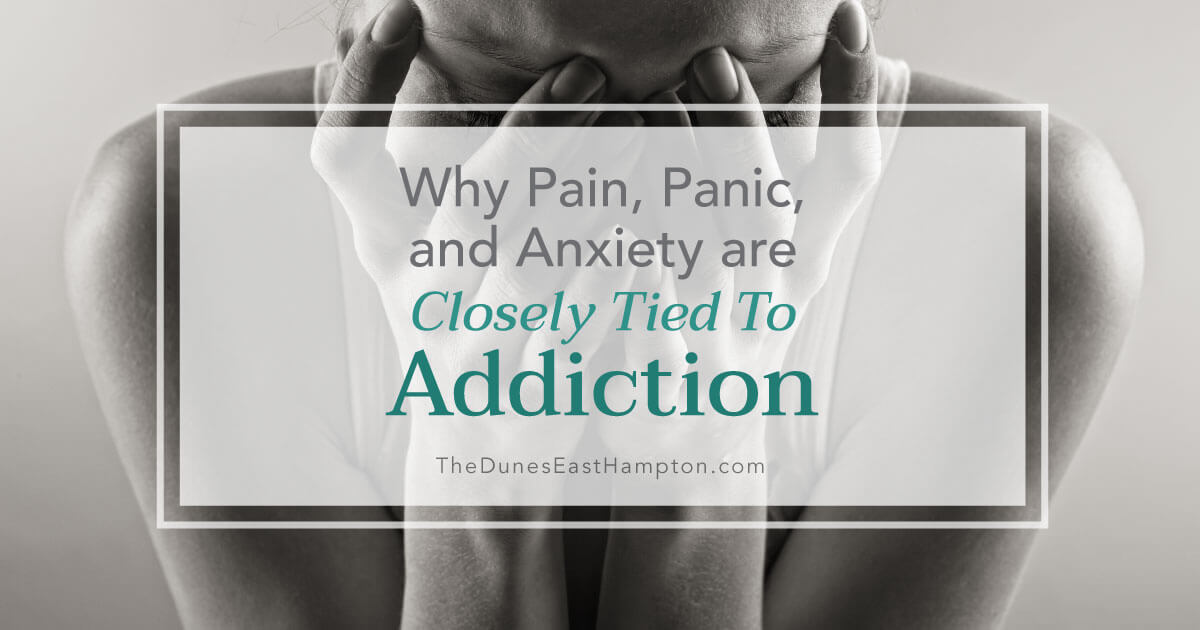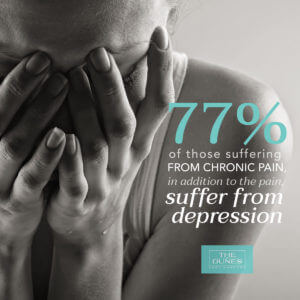
Pain, anxiety and panic are the most common side effects of withdrawal from alcohol and drugs. When recovering from addiction to alcohol and drugs like opioids, heroin, methamphetamine, benzodiazepines, and other illicit drugs, users often cite these 3 side effects as the “worst part” of withdrawal. Incidentally, a majority of substance abusers that initially began abusing due to self-medication overwhelmingly cite these 3 symptoms as the feelings they were trying to rid themselves of when they started. With these symptoms being present in so many parts of addiction – from sobriety to experimentation to addiction – it is evident that there must be a tie between addiction, pain, panic and anxiety. So what is the relationship that addiction has between panic, pain and anxiety?
Pain and Substance Abuse
Over 100 million Americans admit to suffering from chronic pain, with a cost to the American economy of $600 billion per year from these afflictions. Surveys show that 60% of patients that experience chronic pain say that the pain has a severe, negative impact on their quality of life and wellbeing. Additionally, 77% of those suffering from chronic pain say that in addition to the pain, they also suffer from depression. Further, 74% admit that their energy levels are negatively affected, and 86% say that the pain affects their ability to sleep. From these statistics, it is easy to deduce that chronic pain puts a strain on every portion of an individual’s life and health, and it is only natural for these individuals to seek relief from every symptom, from the chronic pain to its unpleasant side effects.
Painkillers and Opioids for Pain Management
When a patient is experiencing pain, the best course of action is to locate the source of the pain and neutralize the pain directly using surgical, orthopedic or other forms of medicine to “stop” the pain. However, if the source of the pain cannot be found, or if the main cause of the pain is not able to be “fixed,” the next course of treatment is pain management – which is the day-to-day treatment of the pain itself, rather than the treatment of an underlying cause for the pain. The most common form of pain management today is through the use of analgesics and painkillers to dull the brain’s response to pain. In this therapy, medications block the brain’s pain signals, keeping a patient from consciously “feeling” the anxiety pain, though the pain is still there. Unfortunately, this only masks the pain for short periods of time, and opioid painkillers and other pain management medications have to be taken long-term – and in increasing amounts – to keep the pain levels at-bay.
Abusing Alcohol for Pain Management
Also common in chronic pain suffers, is the individual self-medicating with alcohol in an attempt to dull any both the pain and the side effects from chronic pain, including depression, anxiety, sleeplessness, and emotional effects. Much like using opioids for pain management, alcohol only dulls the conscious feeling of pain, but the pain is still there and will resume after the alcohol starts to metabolize.
Both drugs and alcohol offer only temporary relief from chronic pain, and both carry with these substances cause a great amount of harm to the body, and carry high risks of addiction. In-short medicating the pain with substances is not a long-term solution for pain management, and only brings long-term dependence.
Pain as a Side Effect to Drug and Alcohol Withdrawal
Firstly, it is important to understand what withdrawal is. Withdrawal – in layman’s terms – is the body and the brain attempting to correct responses and bodily processes without the presence of the drugs or alcohol that it has become accustomed to being in the body for long amounts of time. Essentially, the brain and body have re-wired themselves to function around the presence of these substances, and the balance of the brain and body has been completely thrown off.
The main reason for the extreme pain during withdrawals is due to the extended time of being desensitized to pain, due to the pain receptors being blocked by drugs such as opioids and even alcohol. When these substances are out of the body, there is nothing to block the pain receptors in the brain, and they are wide open for the first time in days, weeks or months. During this time, even natural levels of stimuli to the pain receptors are greater than normal, and manifest as pain. In the case of alcohol withdrawal, acute alcoholics’ brains try and rebalance themselves so quickly and violently that the nervous system response overpowers the body and attacks the heart, brain and other systems. This, in particular, is why alcohol withdrawals are known to be deadly.
Panic, Anxiety and Substance Abuse
Panic and anxiety share similar symptoms; heart palpitations, sweating, trembling and shaking, chest pain, nausea and abdominal distress, fear of losing control, and the feeling that you are either going crazy or dying. These are truly devastating effects of having to endure but are naturally occurring in humans and is a part of our “fight or flight” mechanisms and our instincts for survival. Those suffering from panic and anxiety disorders have above average response of these mechanisms, and can get these symptoms regularly and seemingly out of nowhere. While these symptoms generally are not harmful, and more frightening than anything, they do mimic the symptoms of more severe diseases such as heart failure, thyroid issues or breathing disorders – leading many to believe the symptoms are much more than a natural response.
Self-Medicating for Panic and Anxiety Attacks
As we stated previously, panic and anxiety pain symptoms can be quite distressing and can cause the sufferer to feel that they are seriously ill or dying. Because the fear associated with panic and anxiety can be debilitating, some need to be put on medication to control the attacks, and others choose to self-medicate in an attempt to control the symptoms. For decades the treatment of panic and anxiety was treated nonchalantly with prescription medications such as benzodiazepines; while these medications do alleviate the short-term intensity of panic, they carry with them dangerous side effects including accidental overdoses and addiction. Because of these risks, the medical community is now looking at benzodiazepines as NOT EFFECTIVE in the treatment of anxiety, and the prescribing criteria for these drugs are also heavily under review.
Self-Medicating Anxiety with Alcohol
One of the many popular reasons people consume alcohol in social settings, is that they feel it “loosens them up,” and they can become more open without feeling anxious or overthinking their situations. Alcohol DOES affect many portions of the brain and how it works under the influence, including suppressing many of the classic symptoms of anxiety and panic in the short-term. Users may feel temporary relief from their anxiety after consuming alcohol, though the substance is not a cure or a treatment for anxiety; in fact, alcohol causes damage to the brain and body that often exacerbate anxiety and panic disorders in the long-term. Those that attempt to try and control anxiety with alcohol are truly putting off the brain’s response to stressors until a later time, and this leads to panic and anxiety attacks becoming more common and much more intense.
Panic and Anxiety as Side Effects to Drug and Alcohol Withdrawal
In the way that the mind and body feel immense pain when withdrawing from prescription painkillers and opioid drugs, so do the brain and body feel increased anxiety and panic when withdrawing from drugs and alcohol. Even an individual without anxiety disorders will go through panic attacks and anxiety when stopping the use of drugs and alcohol; when an individual who regularly gets anxiety is going through withdrawals, they too will feel withdrawals. The perception of these withdrawals for someone who has had a history of self-medicating will often seem even more intense.
 We mentioned that what makes anxiety and panic attacks so frightening is that they mimic real diseases and the symptoms of dangerous diseases. In the case of drug and alcohol withdrawal, the body and brain are “not feeling quite right,” and the body is trying to rebalance itself. This rebalancing causes real symptoms in the body that can mimic heart failure, endocrine issues, and a myriad of life-threatening diseases. While the individual may consciously know that symptoms such as heart palpitations, high fever, nausea, and other symptoms are due to the substances leaving the system, the brain and body do not know this. Your body, upon experiencing these symptoms, puts out the call, “fight or flight” to protect it from the feelings that it doesn’t like. This call for help manifests itself as panic attacks and anxiety in those going through withdrawal.
We mentioned that what makes anxiety and panic attacks so frightening is that they mimic real diseases and the symptoms of dangerous diseases. In the case of drug and alcohol withdrawal, the body and brain are “not feeling quite right,” and the body is trying to rebalance itself. This rebalancing causes real symptoms in the body that can mimic heart failure, endocrine issues, and a myriad of life-threatening diseases. While the individual may consciously know that symptoms such as heart palpitations, high fever, nausea, and other symptoms are due to the substances leaving the system, the brain and body do not know this. Your body, upon experiencing these symptoms, puts out the call, “fight or flight” to protect it from the feelings that it doesn’t like. This call for help manifests itself as panic attacks and anxiety in those going through withdrawal.
Anxiety during withdrawal from alcohol is known to be particularly discomforting and acute, and for a good reason. Alcohol withdrawals can kill you, and your body sees this in the extreme withdrawal symptoms that affect the heart, vital organs, and chemical systems of the body. Alcohol withdrawals are particularly more intense, harsh, and medically worrisome than that of other substances, so it is natural for your bodies cry for help to be louder with alcohol withdrawals.
The Never-Ending Cycle of Pain, Panic, Anxiety and Addiction
The main relationship that all three symptoms ailments of pain, anxiety and panic have to addiction, is that they are all natural responses by the human body to negative stimuli. These responses do not feel good at all, for your conscious mind, your subconscious brain and your body and can be particularly distressing. The main thing you must remember is that using substances, alcohol, illicit drugs, or even prescription drugs will not fix the problem, and may actually make the problem worse. With prescription painkillers and opioids, we see medical and pharmaceutical professionals shifting their prescribing standards due to the nationwide opioid and prescription drug epidemic. The general consensus is that the risks of addiction far outweigh the short-term benefits of drugs and alcohol, and this is how the general public needs to look at these substances as well.
For those already struggling with addiction and dependence to alcohol and drugs, the next step is addiction treatment. The cycle of pain, anxiety and panic with addiction paint a clear picture that abusing drugs and alcohol will not help you rise above your physical and mental ailments, and will only bring you around full-circle and in worse shape than when you started.







